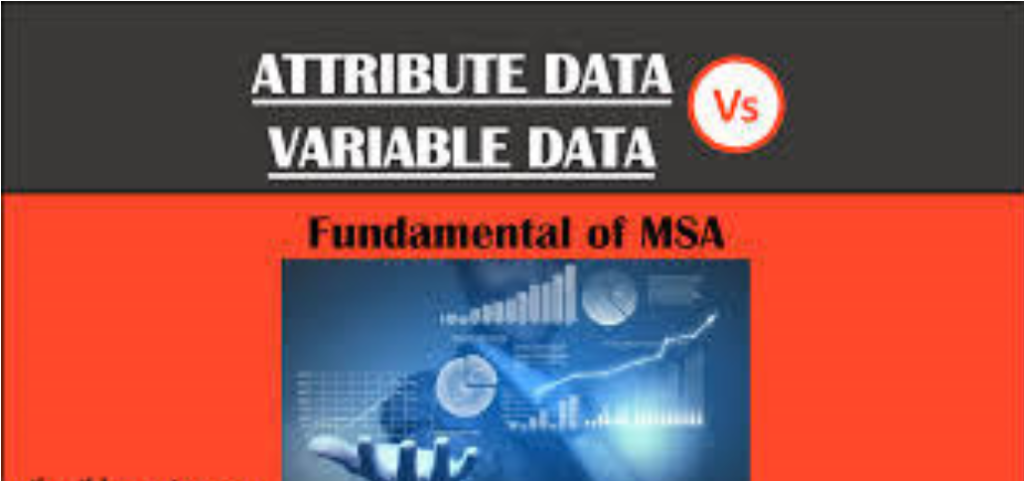What is the key difference between Variable and Attribute MSA Study?


Ethics is knowing the difference between what you have a right to do and what is right to do: Potter Stewart
Introduction
In all organization, the policy of ‘Carrot and Stick’ is followed. Both ‘Carrot and Stick’ have their specific purpose and are used in tandem. At homes too, parents use this policy judiciously to manage their teenage children. For ages, politicians are masters in using this policy effectively.
Objective
The organization collects both variable and attribute data, analyse them and take suitable actions accordingly. The data should be devoid of any error and should be close to its true value. The MSA study helps the organization to capture the measurement bias (Type I and Type II) from the data so that appropriate actions can be taken on the collected data.
By understanding and having clarity about key difference and benefits of variable and attribute data analysis, the organization can fulfil the management’s and customer’s expectations effectively.
Definitions: MSA (Measurement System Analysis) 4th Edition
Bias: The difference between the observed average of measurements and the reference value.
Linearity: The change in bias over the normal operating range.
Stability (Drift): The total variation in the measurement obtained with the measurement system on the same master or parts when measuring a single characteristic over an extended time period. Stability is the change in bias over time.
Repeatability: Variations in the measurements obtained with one measuring instrument when used several times by an appraiser while measuring the identical characteristic on the same part.
Reproducibility: Variation in the average of the measurements made by different appraisers using the same gauge when measuring a characteristic on a part.
Detailed Information
In any measurement system, there is a quantifiable risk in making decisions. The Measurement Systems Analysis is a key step to any process improvement effort. By understanding existing measurement systems, a team can better understand the data provided by those systems and make better business decisions.
The MSA study helps the organization to identify the measurement error in variable and attribute data. The key reason for the error is Type I and Type II error. Once we have clarity about it, the organization can decide why and what type (Variable and Attribute) of MSA study has to be conducted.
Variable Data: Quantitative data that can be acquired through measurements, meaning the data which can be used to measure some physical characteristics such as length, width, temperature, time, strength, thickness, pressure, and so on. Variable means the measured values can vary anywhere along a given scale.
Attribute data: Qualitative data that have a quality characteristic or attribute that is described in terms of measurements. Attribute data is something that can be measured in terms of numbers or can be described as either yes or no for recording and analysis. It is purely binary like Good or Bad, Hot or Cold, Right or Wrong, Black or White, Fitment good or Fitment not good, identification tag available or not etc.
How to measure variable and Attribute data?
Variable Data Measurement: Measuring instrument like Vernier, Micrometer, CMM, Hardness Tester, Pressure Gauge etc.
Attribute Data Measurement: 5 Senses (Sight, Hearing, Touch, Smell, Taste), Fitment Gauge etc.
Possible Error in Variable and Attribute data measurement:
Type I Error: The good part is sometimes called ‘bad’ / Producer risk / False Alarm.
Type II Error: The bad part is sometimes called ‘good’ / Consumer risk / Miss Rate.
Incorrect Decision due to Measurement error:
- Calling a common cause, a special cause
- Calling a special cause, a common cause
Sources of Error (SWIPE):
S: Standard
W: Work Piece
I: Instrument
P: Personnel / Procedure
E: Environment
Purpose of conducting the study:
- Whether the measurement system variability is small compared with the process variability?
- Whether the measurement system is capable of distinguishing between different parts?
Key difference between Variable and Attribute Study:
| S.No. | Variable Study | Attribute Study |
| 1 | Continuum of Values | A finite number of Values |
| 2 | Plots continuous measurement process data such as length, temperature etc. | Control chart plots count data like the number of defects or defectives |
| 3 | How each inspector is measuring the dimension and with how much error | How each inspector is giving the right decision (good or bad sample) |
| 4 | help you identify causes of variation to investigate | |
| 5 | For dimensional error | An aesthetic error like Colour-Red-different shades |
| For Gauges: go or not go | ||
| For burr/flash: accepted or not | ||
| Plug Gauge: tight or lose | ||
| 6 | Does not tell whether the error is a Type I or II | Help to identify Type I and Type II error |
Present Challenges:
- Generally, the organizations consider micrometre, vernier calliper and height gauge for conducting variable study although the standard requires to cover all type of measurement system!
- The key intent of the MSA study is to measure the appraisee error but the MSA plan only specify the list of instruments and dates and never the name of the appraise!
- How often the appraiser is competent in conducting an MSA study?
References:
IATF 16949: 2016
MSA 4th Edition (Measurement System Analysis)- AIAG
Industry Experts
This is the 101st article of this Quality Management series. Every weekend, you will find useful information that will make your Management System journey Productive. Please share it with your colleagues too.
Your genuine feedback and response are extremely valuable. Please suggest topics for the coming weeks.

Find it as near to the concept clear
Thanks Mukesh for your comment